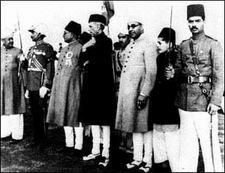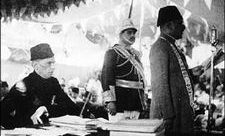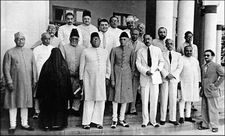Adil Najam
One wonders how many of us have actually read the actual text of the ‘Lahore Resolution’ (Qarardad i Lahore) and later became better known as the ‘Pakistan Resolution’ (Qarardad i Pakistan). We have carried it before on ATP and we carry the full and actual text of the resolution again today as we prepare for March 23 festivities. In fact, one could argue that events these last months – especially in terms of our own treatment of minorities – have added new poignancy to the text of the resolution.
But first, by way of context, maybe we should repeat a few points made the first time we posted this text:
If there is a single most important founding document of Pakistan, it has to be this Resolution passed at the annual session of the All India Muslim League at its 1940 meeting (22-24 March) at Minto Park (now called Iqbal Park), Lahore (by the way, what a wonderful idea – for political parties to have annual, open, meaningful, annual sessions where real decisions are taken in a transparent and democratic manner!). In 1941, this Lahore (Pakistan) Resolution became part of the Muslim League constitution and in 1946 it became the basis of the demand for Pakistan.
Most Pakistanis know what the resolution says; or, at least we think we do; in most cases rightly so. But because we are so very sure that we know what it says, we usually do not take the time to actually read it. Maybe we should. And there cannot be a better day to do so than today.
Like many of the most important documents in history, the Lahore Resolution a fairly short text. We reproduce it here in full.
While approving and endorsing the action taken by the Council and the Working Committee of the All-India Muslim League, as indicated in their resolutions dated the 27th of August, 17th & 18th September and 22nd of October, 1939, and 3rd of February, 1940 on the constitutional issue, this Session of the All-India Muslim League emphatically reiterates that the scheme of federation embodied in the Government of India Act 1935, is totally unsuited to, and unworkable in the peculiar conditions of this country and is altogether unacceptable to Muslim India.
It further records its emphatic view that while the declaration dated the 18th of October, 1939 made by the Viceroy on behalf of His Majesty’s Government is reassuring in so far as it declares that the policy and plan on which the Government of India Act, 1935, is based will be reconsidered in consultation with various parties, interests and communities in India, Muslims in India will not be satisfied unless the whole constitutional plan is reconsidered de novo and that no revised plan would be acceptable to Muslims unless it is framed with their approval and consent.
Resolved that it is the considered view of this Session of the All-India Muslim League that no constitutional plan would be workable in this country or acceptable to the Muslims unless it is designed on the following basic principles, viz., that geographically contiguous units’ are demarcated into regions which should be constituted, with such territorial readjustments as may be necessary that the areas in which the Muslims are numerically in a majority as in the North Western and Eastern Zones of (British) India should be grouped to constitute “independent States” in which the constituent units should be autonomous and sovereign.
That adequate, effective and mandatory safeguards should be specifically provided in the constitution for minorities in these units in the regions for the protection of their religious, cultural, economic, political, administrative and other rights and interests in consultations with them and in other parts of (British) India where the Mussalmans (Muslims) are in a majority adequate, effective and mandatory safeguards shall be specifically provided in constitution for them and other minorities for the protection of their religious, cultural, economic, political, administrative and other rights and interests in consultation with them.
This session further authorises the Working Committee to frame a scheme of constitution in accordance with these basic principles, providing for the assumption finally by the respective regions of all powers such as defense, external affairs, communications, customs and such other matters as may be necessary.
What strikes me in re-reading this today – as it had when I had written about it last – is the deep, strong and sincere emphasis that Pakistan’s founding document has on the rights of minorities. It is in sharp contrast to the the reality of the rights of minorities in Pakistan today. Allow me, again, to repeat what I had written about this then:
The complex structure of the language notwithstanding, the sentiment is clear as is its emphasis on the rights of minorities – not just of Muslims as a minority but of non-Muslim minorities in areas where they envisaged Muslim sovereignty. In such a short document, for the founding fathers to have devoted so much space to this issue would suggest that they – having lived as a minority themselves – considered the subject of minority rights to be of particular importance. This is one of the many areas where we were unable to live up to their aspirations.
 As we prepare for our Pakistan Day festivities and lining up what we will do to mark the occasion, let us please put re-reading the document that this day is celebrating on that list. As you re-read it, keep in mind the events just of this last year. Remember the words Asiya Nasir on the death of Shahbaz Bhatti. Think of the treatment meted out to Prem Chand’s coffin. Consider what the Resolution says about rights of ‘regions’ and about what is happening in Baluchistan today. And as you wait in anticipation on what happens in Bangladesh on Pakistan Day tomorrow think again of the points on rights of regions and the consequences of not paying heed to what our founding fathers outlined.
As we prepare for our Pakistan Day festivities and lining up what we will do to mark the occasion, let us please put re-reading the document that this day is celebrating on that list. As you re-read it, keep in mind the events just of this last year. Remember the words Asiya Nasir on the death of Shahbaz Bhatti. Think of the treatment meted out to Prem Chand’s coffin. Consider what the Resolution says about rights of ‘regions’ and about what is happening in Baluchistan today. And as you wait in anticipation on what happens in Bangladesh on Pakistan Day tomorrow think again of the points on rights of regions and the consequences of not paying heed to what our founding fathers outlined.
The Lahore (Pakistan) Resolution, has to be read today as a promissory note. It signifies a set of promises – promises made not to us, but promises made in our name. An honest re-reading of the Lahore Resolution will only remind us that we have not done a good job of keeping the promises made in our name. Maybe Pakistan Day is a good time to begin doing so!






















































for the hidden knowledge of Pakistan flag …read this article
http://pakistanall.blogspot.com/2011/08/what-is-me aning-of-pakistani-flag.html
Sad to say that I had never read this carefully till now myself!
Thank you ATP for highlighting this and for educating all of us!